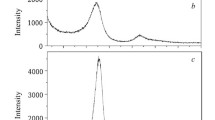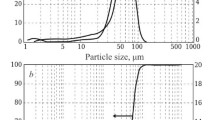It is concluded on the basis of calculations performed for different types of close packing of spherical particles that porous permeable ceramic materials with open porosity greater than 42 ± 3% it is can be created, in practice, from monofractional corundum powder. It is shown that the formation method (semidry pressing and slip casting) and the habit of the crystals affect the open porosity of the ceramic. The chemical resistance of the porous ceramic materials obtained to nitric acid and sodium hydroxide is evaluated.
Similar content being viewed by others
References
B. L. Krasnyi, V. P. Tarasovskii, and A. B. Krasnyi, “Application of ceramic materials for solving ecological problems,” Bezopasn. Okruzh. Sredy, No. 3, 94–96 (2008).
B. L. Krasnyi, V. P. Tarasovskii, and A. B. Krasnyi, “Articles made from porous permeable ceramic — new possibilities for technological breakthrough in principal industries,” Novye Ogneupory, No. 11, 28–30 (2008).
B. L. Krasnyi and V. P. Tarasovskii, “Filtering elements made from porous permeable ceramic with different microstructure and pores regulatable from macro- to nano- sizes for different industries and the municipal housing economy” in: Abstracts of Reports at the Conference on Nanotechnologies — Production-2006 [in Russian], Fryazino (2006), pp. 75–77.
I. Ya. Guzman (ed.), Chemical Technology of Ceramics [in Russian], RIF “Stroimaterialy” JSC, Moscow (2003).
A. P. Karnaukhov, “Globular model of porous bodies with corpuscular structure,” Kinetika Catalis, 12(4), 1025–1033 (1971).
Yu. N. Kryuchkov, Modeling of the Porous Structure and Mass Transfer in Powdered Permeable Materials Taking Account of Nonlinear Structural Effects [in Russian], Kiev (1995).
B. L. Krasnyi, V. P. Tarasovskii, E. V. Rakhmanova, and V. V. Bondar’, “Chemical stability of ceramic materials in acids and alkalis,” Steklo Keram., No. 10, 22–24 (2004).
Author information
Authors and Affiliations
Additional information
Translated from Steklo i Keramika, No. 6, pp. 18–21, June, 2009.
Rights and permissions
About this article
Cite this article
Krasnyi, B.L., Tarasovskii, V.P., Krasnyi, A.B. et al. Properties of porous permeable ceramic based on monofractional corundum powders and nanodispersed binder. Glass Ceram 66, 212–215 (2009). https://doi.org/10.1007/s10717-009-9164-0
Published:
Issue Date:
DOI: https://doi.org/10.1007/s10717-009-9164-0




